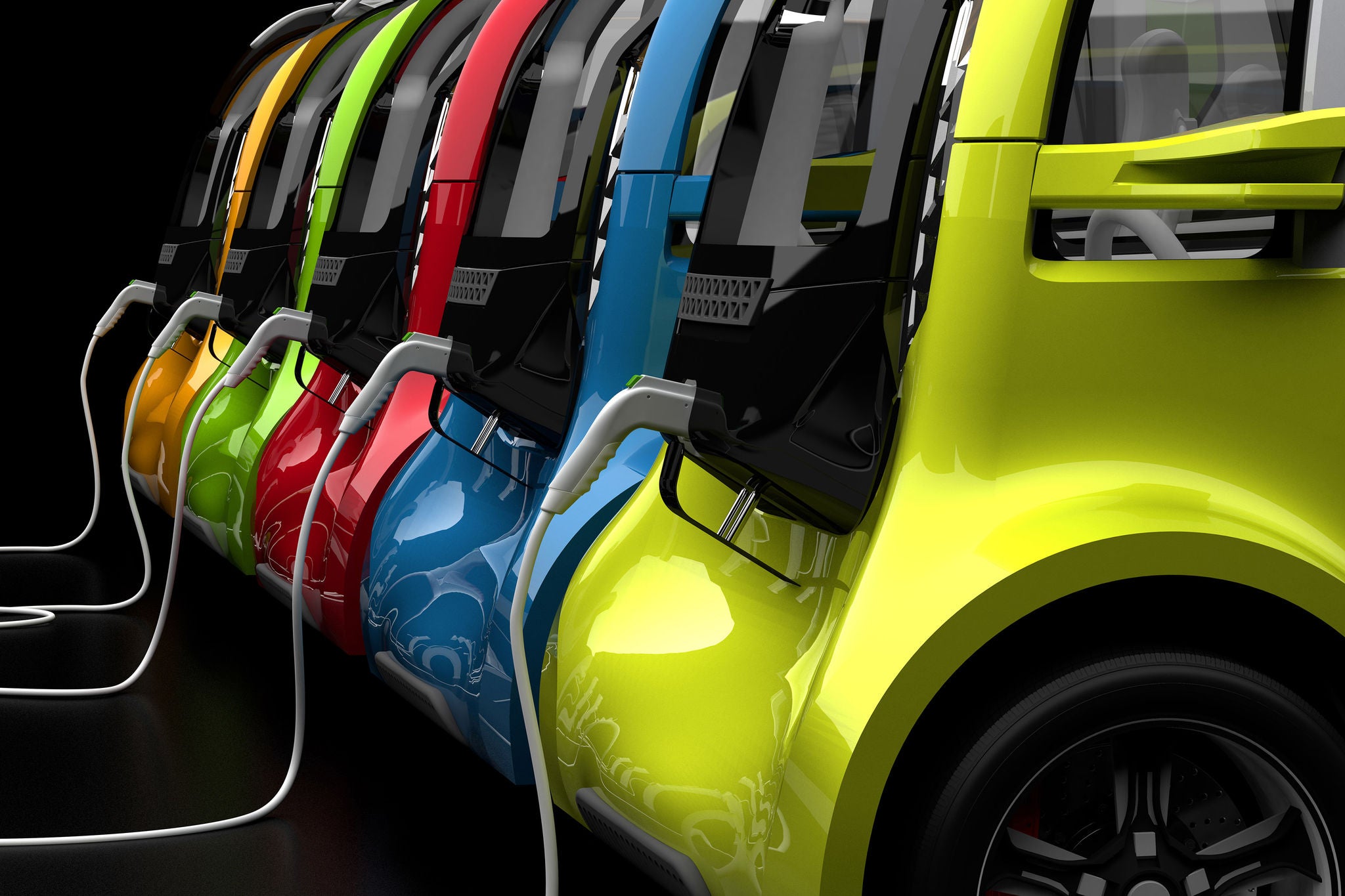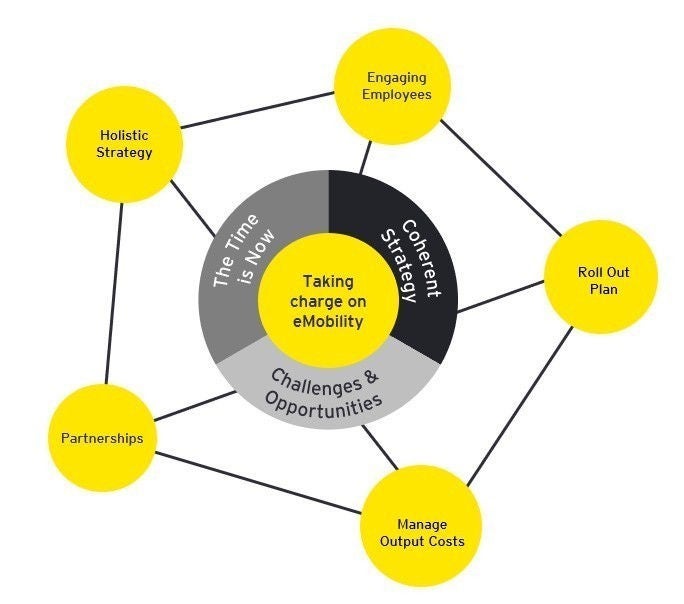EY refers to the global organization, and may refer to one or more, of the member firms of Ernst & Young Global Limited, each of which is a separate legal entity. Ernst & Young Global Limited, a UK company limited by guarantee, does not provide services to clients.

There will be challenges and opportunities for fleet owners. A holistic strategy that allows for a smooth switchover to an EV fleet is the best way forward.
In brief
- Now is the time for organisations to define how they can benefit from an electric fleet and contribute to the 1,000,000 vehicles the Government aims to have on the roads by 2030.
- The success of electric vehicles (EVs) hinges on effective charging infrastructure, the availability of EVs and ensuring the electricity network is ready for the increase in demand for this new mode of transport.
- Project managers need to introduce a coherent and holistic strategy to ensure the transition to an EV fleet has minimum impact on business and economic growth.
The challenge is intimidating.
A government target of 1,000,000 electric vehicles (EVs) and low-emitting vehicles on Irish roads by 2030 may seem to some like a distant prospect, but it is fast approaching.
Fleet transformation is essential for meeting this net zero target. Commercial fleets make up a large proportion of vehicle ownership – 25% of all registered vehicles in the UK¹, for example. Commercial fleet operators are beginning to focus on transitioning to a clean future through fleet electrification.
Lower total cost of ownership, better vehicle technology and government plans to improve the charging network density are combining to prompt fleet owners to implement changes in their business and invest in EVs.
There are clear signs an EV sales boom could soon take off. In Q1 2022, 6,000 EVs were registered in Ireland, double the number registered over the same period in 2021². Globally, the 2022 EY Mobility Lens Consumer Index indicated for the first time that more than half of all consumers looking to buy a car want an EV.
The world’s leading countries in the switch to EVs are China, Norway, Sweden, Germany, and the UK, according to the 2022 EY Electric Vehicle Country Readiness Index. The Index looks at the preparedness of the top 14 vehicle markets for the arrival of EVs based on supply, demand and regulation.
The Government has introduced financial incentives for businesses and fleet operators such as an SEAI grant for commercially purchased EVs, which could deliver fleet owners a saving of up to €3,800 per vehicle. For company vehicles for staff and directors, benefit in kind tax for battery electric vehicles (BEVs) is levied at a rate of 0% on the first €50,000 of the vehicle’s value. VRT relief of up to €5,000 is also available for BEVs³.
Challenges and opportunities
As countries implement their own net zero policies post the pandemic, the demand for EVs is on track to soar worldwide, which will lead to both challenges and opportunities for fleet owners.
The most imminent challenge for fleet owners is the lack of accessible charging points. As of 2022, there are approximately 1,900⁴ public charging points nationwide in Ireland for EVs. More will be required if we are to reach our climate targets.
This issue will only intensify as demand for EVs continues to increase. As part of the EU’s Fit for 55 package, internal combustion cars will effectively be banned from sale from 2035, directly affecting the EU’s 440 million inhabitants. Charging infrastructure is crucial if this ambition is ever to be achieved.
This surge in demand will also lead to a change in the electricity demand on the grid, specifically on the distribution network. In Ireland, the demand for electricity from EV charging is estimated to be 40,000 MWh per week by 2030⁵. The grid will need to cope with near exponential growth in EVs, but unmanaged charging could result in voltage deviations and heavily loaded grids could become bottlenecks during the e-mobility rollout⁶.
These challenges have been exacerbated by both global supply chain backlogs and the Ukraine crisis.
Although these factors can be viewed as barriers, they also present opportunities for business owners. Companies can be proactive and innovative to find creative solutions to complement the existing charging supply, such as micro-depots in high density urban areas or re-designing existing depots to service EVs. These have successfully been rolled out by courier companies in the UK, which built them in preparation for the ultra-low emissions zones in central London.
A five-step plan of action
One of the best ways to control challenges and avail of opportunities is to develop a coherent strategy. Fleet owners should consider five areas when developing a plan of action to smoothly switch over to an EV fleet.
Holistic strategy: Considering all elements within a business holistically that may be impacted by the introduction of EVs will increase the prospect of businesses realising the combined benefits from their investment in an EV fleet.
Rollout plan: Investing time to review the key steps to introduce EVs in a business can lead to more efficient operations and ensure all aspects of customer requirements are considered.
Manage output costs: Costs are a huge factor when looking to transferring from a fleet of internal combustions engine (ICE) fleet to EVs. In comparison to conventional petrol and diesel vehicles, operational costs are likely to change significantly. Purchasing cost of the vehicle, running costs, taxes, insurance, depreciation, and resale value can also vary when comparing to conventional ICE vehicles. These all need to be factored into any business model for a fleet owner. To mitigate some high purchasing costs that EV owners may face, fleet owners could look at leasing opportunities instead of buying EVs outright.
Partnerships: There are myriad organisations and government bodies in the EV world, including system operators, automakers and ultimately, the consumer. Engagement between fleet owners and automakers is crucial to push for better accessibility to EVs and further understand the tax incentives and grants available to businesses.
Engaging employees: In an environment where competition for talent is fierce, placing employees at the centre of this business change should be the key focus for getting the employee experience right and ensure they are committed to the change to EVs.

How EY can help
Launched in Ireland earlier this year, EY Carbon helps clients to 1. Plan, 2. Transform and 3. Report their decarbonisation journey, drawing on unrivalled multi-discipline expertise to develop value-led strategies and assist in building credible business cases for transformation.
Summary
Fleet owners have a central role to play in reaching our 2030 net zero targets and the green transition is at the centre of many businesses. The time is now. Those that adopt a coherent strategy when investing in EVs will be positioned to benefit the most.
Related articles
How to plan for decarbonisation towards the Net Zero Transition
With climate action ascending to the top of the business agenda, the reality of corporate decarbonisation is hitting home.




